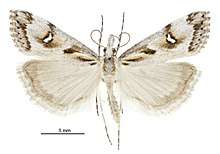Gadira leucophthalma
Gadira leucophthalma, commonly known as the beaked moss moth, is a moth in the family Crambidae. It is endemic to New Zealand. This species has been classified as Nationally Vulnerable by the Department of Conservation.
| Gadira leucophthalma | |
|---|---|
 | |
| Male | |
| Scientific classification | |
| Kingdom: | |
| Phylum: | |
| Class: | |
| Order: | |
| Family: | |
| Genus: | |
| Species: | G. leucophthalma |
| Binomial name | |
| Gadira leucophthalma (Meyrick, 1882) | |
| Synonyms | |
| |
Taxonomy
This species was first described by Edward Meyrick in 1882 from specimens collected in the Port Hills near Lyttelton and named Thinasotia leucophthalma.[2] Thinasotia was a misspelling by Meyrick of the genus Thisanotia.[3] Meyrick gave a more detailed description of the species in 1883.[4] In 1895 George Hampson placed this species within the genus Talis.[5] This placement was followed by Meyrick in 1913,[6] George Vernon Hudson in 1928,[7] and in 1930 by Alfred Philpott, who studied the male genitalia of the species.[8] In 1973 David E. Gaskin assigned the species to the genus Gadira.[9] The lectotype specimen of this moth is held at the Natural History Museum, London.[3]
Distribution
G. leucophthalma is endemic to New Zealand.[10][11] Along with its type location of Lyttelton hills, this species has also been collected on Mount Gray,[7] on Kaitorete Spit,[12][13][14] and on Banks Peninsula,[15] all in Canterbury. G. leucophthalma is also recorded as being present at Cloudy Bay.[16]
Description
This species is visually very similar to Gadira petraula but it can be distinguished as G. leucophthalma is slightly larger and the edges of its forewings are more lightly coloured.[15] Both G. leucophthalma male and females have variable colour patternation on their wings.[16] The females have variable wing length.[16]
Biology and behaviour
Meyrick originally collected adults of the species in March but subsequently took it in December.[17] Specimens have also been collected in November.[7] However it is more commonly seen from March to April.[13] The species is a day flying moth although some specimens have been trapped at night with UV light.[16]
Habitat
G. leucophthalma prefers to inhabit foredunes.[13] The species has also been found to inhabit areas of bristle-grass with moss present.[16]
Host plants
The host plants of this species is unknown although it has been hypothesised that the larvae feed on moss.[16]
Conservation Status
This species has the "Nationally Vulnerable" conservation status under the New Zealand Threat Classification System.[1]
References
| Wikimedia Commons has media related to Gadira leucophthalma. |
- Hoare, R.J.B.; Dugdale, J.S.; Edwards, E.D.; Gibbs, G.W.; Patrick, B.H.; Hitchmough, R.A.; Rolfe, J.R. (2017). "Conservation status of New Zealand butterflies and moths (Lepidoptera), 2015" (PDF). New Zealand Threat Classification Series. 20: 6.
- Meyrick, Edward (1882). "Descriptions of New Zealand Micro-Lepidoptera (I.)". New Zealand Journal of Science. 1: 186–187 – via Biodiversity Heritage Library.
- Dugdale, J. S. (1988). "Lepidoptera-annotated catalogue, and keys to family-group taxa" (PDF). Fauna of New Zealand. 14: 1–264 – via Landcare Research New Zealand Ltd.
- Meyrick, Edward (1883). "Descriptions of New Zealand Micro-Lepidoptera". Transactions and Proceedings of the New Zealand Institute. 15: 3–68. Retrieved 5 May 2018.
- Hampson, George F. (1895). "On the classification of the Schoenobiinae and Crambinae, two subfamilies of moths of the family Pyralidae". Proceedings of the Zoological Society of London. 1895: 897–974. Retrieved 5 May 2018.
- Meyrick, Edward (1913). "A Revision of the New Zealand Pyralidina". Transactions and Proceedings of the New Zealand Institute. 45: 30–51 – via Biodiversity Heritage Library.
- Hudson, G. V. (1928). The Butterflies and Moths of New Zealand. Wellington: Ferguson & Osborn Ltd. p. 172.
- Philpott, Alfred (1930). "The Male Genitalia of the New Zealand Crambidae". Transactions and Proceedings of the Royal Society of New Zealand. 60: 491–514.
- Gaskin, David E. (1973). "Revision of New Zealand Chilonini (Lepidoptera; Pyralidae) and redescription of some Australian species". New Zealand Journal of Science. 16: 435–463.
- "Gadira leucophthalma (Meyrick, 1882)". www.nzor.org.nz. Landcare Research New Zealand Ltd. Retrieved 2017-07-11.
- Gordon, Dennis P., ed. (2010). New Zealand inventory of biodiversity. Volume two. Kingdom animalia : chaetognatha, ecdysozoa, ichnofossils. Vol. 2. Christchurch, N.Z.: Canterbury University Press. p. 457. ISBN 9781877257933. OCLC 973607714.
- Gaskin, David E. (1987). "Supplement to New Zealand Crambinae (Lepidoptera: Pyralidae) — corrections, description of females of two species, and notes on structure, biology, and distribution". New Zealand Journal of Zoology. 14 (1): 113–121. doi:10.1080/03014223.1987.10422688.
- Patrick, Brian (1994). "Lepidoptera of Kaitorete Spit, Canterbury". New Zealand Entomologist. 17: 52–63. CiteSeerX 10.1.1.580.6402.
- Debbie Hogan, Scott Hooson (6 June 2017). Christchurch District Plan Site of Ecological Significance: Kaitorete Spit (PDF) (Report). Christchurch City Council. p. 7. Retrieved 5 May 2017.CS1 maint: uses authors parameter (link)
- "Gadira petraula". Gadira petraula (Meyrick, 1883). Manaaki Whenua - Landcare Research. Retrieved 2018-05-05.
- Dugdale, John S. (2001). Cloudy Bay coastal habitats : entomological values of the foreshore and associated inland habitats (PDF). Nelson, N.Z.: Department of Conservation, Nelson/Marlborough Conservancy. p. 13. ISBN 978-0478220834. OCLC 81750966.
- Meyrick, Edward (1885). "Descriptions of New Zealand micro-lepidoptera". Transactions and Proceedings of the New Zealand Institute. 17: 121–140 – via Biodiversity Heritage Library.
